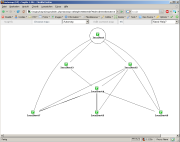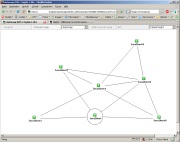

nagvis.ini.php to specify the name of your monitoring server (or any other host which should be the starting point). Please make sure that you use the name you specified in the host_name directive of the host definition. In most real life setups it is not called "localhost" ;-).http://<nagios-server>/<path-to-nagvis>/frontend/nagvis-js/index.php?mod=AutoMap&act=view&show=__automapIf everything is configured properly the root host and 2 levels of child hosts should be displayed on the automap.
etc/automaps. The default map configuration file is named __automap.cfg. All values can be found in the Automap Config Format Description.
The values like iconset etc. are inherited to all objects on the map.
| parameter | default | description |
|---|---|---|
| show | The name of the automap. Since NagVis 1.5 different automap configuration files can be defined. The automap to view needs to be set here. (New in 1.5) | |
| backend | default backend | The backend-id of the backend to fetch the objects from. For details see the [backend_*] section in the Main Config Format Description |
| root | see root object definition | This is the name of the root object. It is not essential to set the host here. There are some more ways to tell the root object. For details see the root object definition chapter on this page. |
| maxLayers | 2 | This option is deprecated. Use childLayers instead (See below). |
| childLayers | 2 | Maximum layers of child hosts to be displayed. (New in 1.5) |
| parentLayers | 0 | Maximum layers of parent hosts to be displayed. (New in 1.5) |
| renderMode | undirected | Set the render mode of the map. For details see available render modes |
| width | 1024 | width of the automap in pixels |
| height | 786 | height of the automap in pixels |
| ignoreHosts | none | comma separated list of hosts (including children) not to display |
| filterByState | none | Set to 1 to enable the "problem automap" mode. When it is set to 1 it will filter all branches out which have only OK/UP hosts. This will result in a "problem automap" which only shows up a tree where each branch has at least one problem. (New in 1.5) |
| filterGroup | none | Provide a hostgroup name. Only hosts in this hostgroup will be shown on the map. |
| search | none | Search for a map object on map load. Matching objects will be highlighted. (New in 1.5) |
| rotation | none | Rotate in the given rotation pool when the map is a step in the pool. (New in 1.5) |
| enableHeader | none | Enable/Disable the header menu. To be given as integer (1/0). Overrides the configuration. (New in 1.5) |
| enableHover | none | Enable/Disable the hover menus. To be given as integer (1/0). Overrides the configuration. (New in 1.5) |
| enableContext | none | Enable/Disable the context menus. To be given as integer (1/0). Overrides the configuration. (New in 1.5) |
root.defaultroot option can be set in the [automap]-section.| Mode | Example image |
|---|---|
| directed |  |
| undirected |  |
| radial | |
| circular | |
| undirected2 |
Since NagVis 1.5 it is possible to export the current automap view as a classic NagVis map. Exporting automaps to classic maps you get the advantages of both worlds.
You can start with the automap to get all the object positioned on your maps using the automap render modes. Once you finished the rendering you can export the automap including the generated background image to a regular map using the "Export to map" which can be found in the "Actions" submenu in your header menu.
With the exported map you can add design elements as you want and customize your layout according to your needs.
A map can be exported multiple times to the same target map. But it will overwrite all changes you made to the target map before. You can only overwrite maps you have edit permissions on.
A classic map can not be turned into an automap.
The URLs of the host objects are used for identifying the host objects during automap rendering. Especially the "host=" parameter is important. When this parameter is missing in the host URLs the object positions can not be gathered.
By default this information should not of interest to you. But when you customize the host URLs in your NagVis installation it is important to know that your custom URL needs to have the "host=" parameter set to the hostname of the object to be able to use the hosts on the automap.